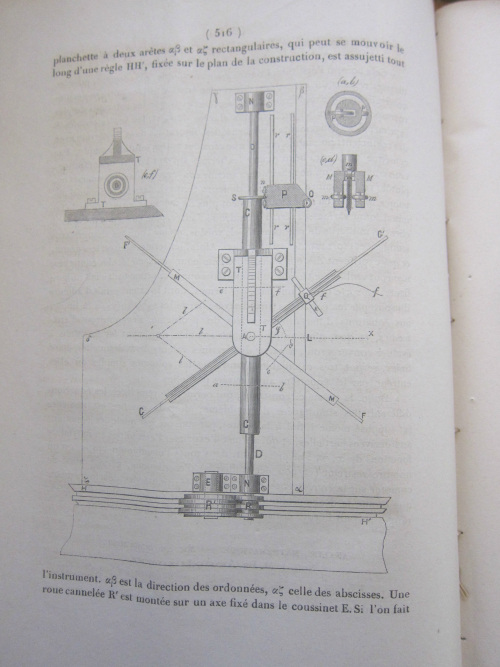Bruno Abdank-Abakanowicz, “Sur un integrateur. instrument servant a l'integration graphique", vol 92, no. 8, 21 February 1881, pp 402-405 in the issue of pp 373-428;Four papers developing his analytical calculating and graphing instrument in three different numbers of the Comptes Rendus (vols 92, 94, and 95), as follows, with the three papers from volumes 92 and 95 offered with their original wrappers. All four papers are disbound from a larger bound volume. GOOD-VERY GOOD condition. SOLD
_____. “Sur un integrateur. instrument servant a l'integration graphique", vol 92, no. 10, 7 March 1881, pp 515-519 in the issue of pp 482-538;
_____. "Sur l'integration mechanique", vol 94, no. 12, 20 March 1882, pp 783-785 in the issue of 753-816;
_____. "Sur un nouvel integrometre", vol 95, no. 22, 27 November 1882, pp 1047-1048 in the issue of pp 1017-1076.
"Integraph, mathematical instrument for plotting the integral of a graphically defined function. Two such instruments were invented independently about 1880 by the British physicist Sir Charles Vernon Boys and the Lithuanian mathematician Bruno Abdank Abakanowicz and were later modified and improved by others. The integraph draws the graph of the integral as the user traces the graph of the given function."--Encyclopedia Britannica
"William Thomson. Lord Kelvin, had the powerful idea of using analog computing mechanisms tied together to solve a differential equatioms. Ten years later, AbdankAbakanowicz built an “integraph.” which had the purpose of solving one particular differential equation. Thomson’s idea was the conception of differential analyzers. which. however. did not become a practical reality until the 1930s with the work of V. Bush.’ Lord Kelvin also invented a pulley device for solving simultaneous equatioms Larger versions were built by MIT professor Wilbur in 1934 and 1935.--AB Clymer, "The mechanical analog computers of Hannibal Ford and William Newell", IEEE Annals of the History of Computers, 15/2
“The mechanical integraph is a noteworthy development in the history of calculating instruments, for it represents an early, albeit limited, analog approach to the solution of differential equations. It is worth noting that it was the need to solve partial differential equations with rapidity and accuracy that ultimately led to the development of the ENIAC...The integraph is an elaboration and extension of the planimeter, an earlier, simpler instrument used to measure area. It is a mechanical instrument capable of deriving the integral curve corresponding to a given curve. Hence, it is able to solve elementary differential equations graphically. Abdank-Abakanowicz concentrated on developing his integraph for several years. However, it was not until 1878 that he succeeded in developing a practical working model.”--from the Erwin Tomash Library site
Also see H. Morin, Les appareils d'intégration: intégrateurs simples et composés; planimètres; intégromètres; intégraphes et courbes intégrales; analyse harmonique et analyseurs,pp 136-141, for descriptions of the Abdnak-Abakanowicz machines (as referred by Tomash). The full text of the Morin is found on the Cornell University classic maths books site.




Comments